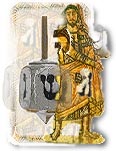As the
name from the German dreihen, "to spin," implies, this
is a spinning top (in Hebrew sevivon). This top was popular in medieval
Germany; its letters in Latin characters: N-nisht (nothing); G-gantz
(all); H-halb (half) and S-shtel (put), were transferred to
popular Jewish script and usage. Symbolically, the top recalls the "turnover"
of events when Judah the Maccabee's few forces vanquished and toppled the
many in Antiochus' army. The natural sequence of events was overturned:
the strong were spun into the hands of the weak, as enunciated in the Al-ha-Nissim
prayer of Hanukkah.
To justify
the gambling, many interpreted the game as a disguised form of studying. When
the Jews were not allowed to engage in the study of the Law, they would assemble
to play the game and at the same time discuss the Law orally. The Hebrew letters
nun, gimel, heh, shin on the dreidel are usually explained as the initial
letters of the phrase that epitomized the great event >—
Nes gadol hayah sham, "A great miracle happened there." However,
these letters became directions for a put-and-take game; indicating nun
>—
take nothing; gimel >—
take all; heh >—
take half, and shin >—
put in the pot. In Israel the letters are changed to nun, gimel,
heh, peh; the peh, meaning poh (here), referring
to the Temple area; but this was not universally accepted.
 Though
the playing of the teetotum (dreidel) originated in medieval days and was
very popular in mid-nineteenth century London under its name, derived from
the letter T on one side, meaning totum ("take all"), it
was given a Jewish characterization by the rabbis' "discovery" that
the letters were "prophesied" in the Bible. Confirmation was found
in the biblical portion read in the Hanukkah period, i.e., the story of Judah's
coming to Goshen. The Bible relates that when Jacob planned to visit Joseph
in Egypt and to settle there temporarily, he sent Judah to precede him, "to
point the way...to Goshen" (Genesis 46:28). The Hebrew letters of Goshna,
"to Goshen," are similar to those on the dreidel, emphasizing that
Jacob's son Judah, as well as Judah the Macabee, preceded to show the way
for all Israel. Since the letters on the dreidel are equal in numbers to the
letters in Mashiah, Messiah (both are equivalent to 358), many believed
that the Messiah of the House of Judah would be the appointed one, to show
the way for further miracles for Israel. The struggle of the Hasmoneans was
seen as a symbolic reversal of the bondage of Goshen.
Though
the playing of the teetotum (dreidel) originated in medieval days and was
very popular in mid-nineteenth century London under its name, derived from
the letter T on one side, meaning totum ("take all"), it
was given a Jewish characterization by the rabbis' "discovery" that
the letters were "prophesied" in the Bible. Confirmation was found
in the biblical portion read in the Hanukkah period, i.e., the story of Judah's
coming to Goshen. The Bible relates that when Jacob planned to visit Joseph
in Egypt and to settle there temporarily, he sent Judah to precede him, "to
point the way...to Goshen" (Genesis 46:28). The Hebrew letters of Goshna,
"to Goshen," are similar to those on the dreidel, emphasizing that
Jacob's son Judah, as well as Judah the Macabee, preceded to show the way
for all Israel. Since the letters on the dreidel are equal in numbers to the
letters in Mashiah, Messiah (both are equivalent to 358), many believed
that the Messiah of the House of Judah would be the appointed one, to show
the way for further miracles for Israel. The struggle of the Hasmoneans was
seen as a symbolic reversal of the bondage of Goshen.
In
the East European schools of the pre-Hitler period the children during
the early part of the month of Kislev would be busy carving dreidels
from wood or casting them in lead. An allusion to the wood product
was found in the prophetic reading of the week, "And thou, son
of man, take thee one stick, and write upon it: For Judah, and for
the children of Israel, his companions" (Ezekiel 37:16). Thus
the dreidel of wood spelled "unity" for Israel.
The letters
were also mystically interpreted as alluding to the components of man's
being as indicated in the Hebrew: nefesh >—
soul; guf >—
body; sekhel >—
mind; this is hakol >—
"everything," all that characterizes man.
It
was also observed that the four letters (358 together in gematria)
are equivalent numerically to nahash, the serpent or evil spirit.
The dreidel is spun to topple evil and to bring forth the messianic
era establishing God's kingdom. The Hebrew phrase "God is king,
God rules and shall rule" is also the equivalent of 358.
In sum, it
was stressed that the world is like a dreidel. Everything is set forth in
cycles; things change and spin, but all emanate from one Root. The dreidel
reflects the game of chance in life as an on-going event. Its letters are
also the initials of the phrase "You redeemed Your very own tribe; Mount
Zion" (Psalms 74:2).
 |
 From:
Sidney B. Hoenig, "Hanukkah Oddities," in The Hanukkah Anthology
(Philadelphia: Jewish Publication Society, 1992) From:
Sidney B. Hoenig, "Hanukkah Oddities," in The Hanukkah Anthology
(Philadelphia: Jewish Publication Society, 1992)
|



